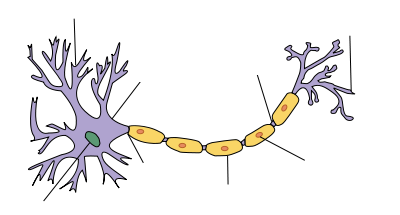Soma (biology)
| Soma |
|---|
| Structure of a typical neuron |
The soma (pl. somata or somas), or perikaryon (pl. perikarya), or cyton, is the bulbous end of a neuron, containing the cell nucleus. The word "soma" comes from the Greek σῶμα, meaning "body"; the soma of a neuron is often called the "cell body". There are many different specialized types of neurons, and their sizes vary from as small as about 5 micrometres to over 10 millimetre for some of the smallest and largest neurons of invertebrates, respectively.
The soma (main part of the neuron in which the dendrites branch off of) contains many organelles, including granules called Nissl granules, which are composed largely of rough endoplasmic reticulum and free polyribosomes.[1] The cell nucleus is a key feature of the soma. The nucleus is the source of most of the RNA that is produced in neurons. In general, most proteins are produced from mRNAs that do not travel far from the cell nucleus. This creates a challenge for supplying new proteins to axon endings that can be a meter or more away from the soma. Axons contain microtubule-associated motor proteins that transport protein-containing vesicles between the soma and the synapses at the axon terminals. Such transport of molecules towards and away from the soma maintains critical cell functions.
The axon hillock is a specialized domain of the neuronal cell body from which the axon originates. A high amount of protein synthesis occurs in this region, as it contains a large number of Nissl granules (which are ribosomes wrapped in RER) and polyribosomes. Within the axon hillock, materials are sorted as either items that will enter the axon (like the components of the cytoskeletal architecture of the axon, mitochondria, etc.) or will remain in the soma. In addition, the axon hillock also has a specialized plasma membrane that contains large numbers of voltage-gated ion channels, since this is most often the site of action potential initiation.[1]
The survival of some sensory neurons depends on axon terminals making contact with sources of survival factors that prevent apoptosis. The survival factors are neurotrophic factors, including molecules such as nerve growth factor (NGF). NGF interacts with receptors at axon terminals, and this produces a signal that must be transported up the length of the axon to the nucleus. A current theory of how such survival signals are sent from axon endings to the soma includes the idea that NGF receptors are endocytosed from the surface of axon tips and that such endocytotic vesicles are transported up the axon.[2]
ReferencesISBN links support NWE through referral fees
- ↑ 1.0 1.1 (2008) Fundamental Neuroscience, 3rd, Academic Press. ISBN 978-0-12-374019-9.
- ↑ Delcroix JD, Valletta J, Wu C, et al. (2004). Trafficking the NGF signal: implications for normal and degenerating neurons. Prog. Brain Res. 146: 3–23.
External links
- Template:OklahomaHistology - "Slide 3 Spinal cord"
Neurons (gray matter): soma, axon (axon hillock, axoplasm, axolemma, neurofibril/neurofilament), dendrite (Nissl body, dendritic spine)
types (bipolar, pseudounipolar, multipolar, pyramidal, Purkinje, granule)
Afferent nerve/Sensory nerve/Sensory neuron (GSA, GVA, Type Ia sensory fiber), Efferent nerve/Motor nerve/Motor neuron (GSE, GVE, Alpha motor neuron, Gamma motoneurons, Upper motor neuron, Lower motor neuron), Interneuron (Renshaw)
Synapses: neuropil, boutons, synaptic vesicle, neuromuscular junction, electrical synapse
Sensory receptors: Free nerve ending, Meissner's corpuscle, Merkel nerve ending, Muscle spindle, Pacinian corpuscle, Ruffini ending, Olfactory receptor neuron, Photoreceptor, Hair cell, Taste bud
Glial cells: astrocyte, ependymal cells, microglia, radial glia
Myelination (white matter): Schwann cell, oligodendrocyte, nodes of Ranvier, internode, Schmidt-Lanterman incisures, neurolemma
closely related Connective tissue: epineurium, perineurium, endoneurium, nerve fascicle, meninges
Credits
New World Encyclopedia writers and editors rewrote and completed the Wikipedia article in accordance with New World Encyclopedia standards. This article abides by terms of the Creative Commons CC-by-sa 3.0 License (CC-by-sa), which may be used and disseminated with proper attribution. Credit is due under the terms of this license that can reference both the New World Encyclopedia contributors and the selfless volunteer contributors of the Wikimedia Foundation. To cite this article click here for a list of acceptable citing formats.The history of earlier contributions by wikipedians is accessible to researchers here:
The history of this article since it was imported to New World Encyclopedia:
Note: Some restrictions may apply to use of individual images which are separately licensed.
